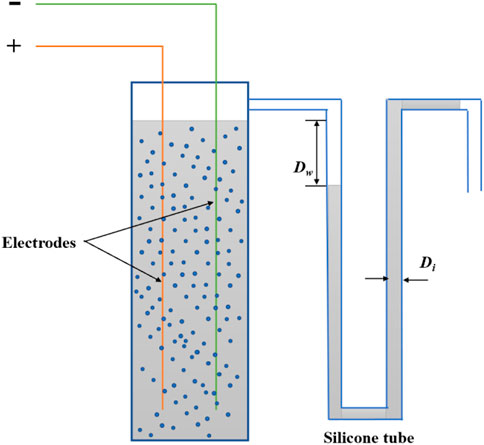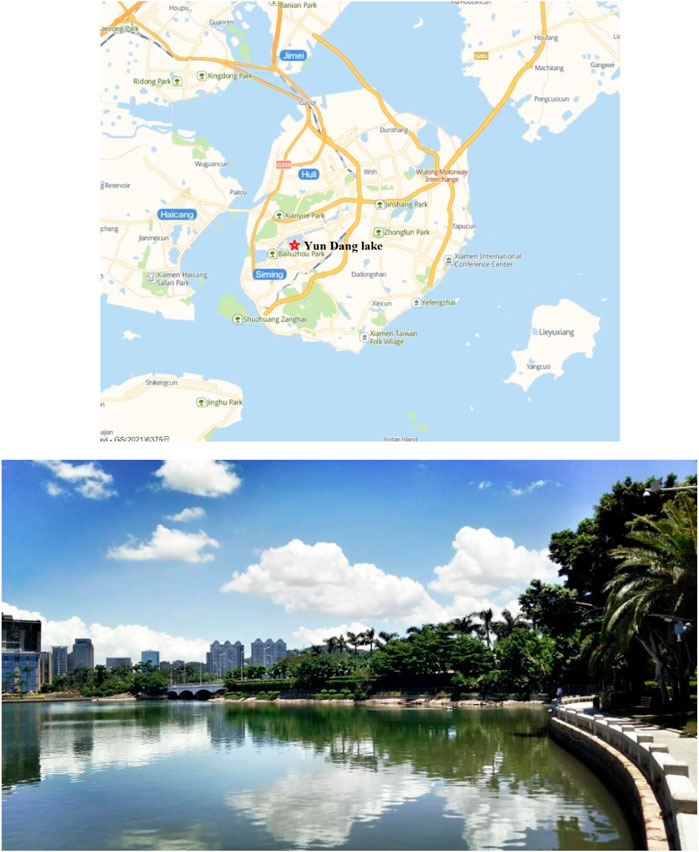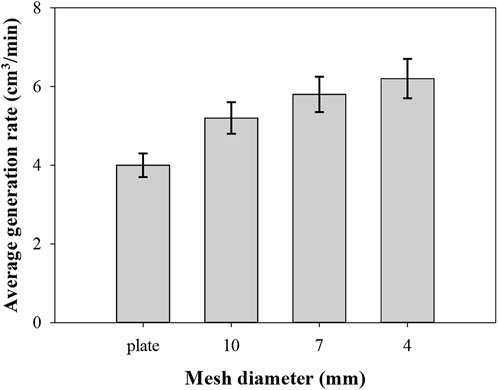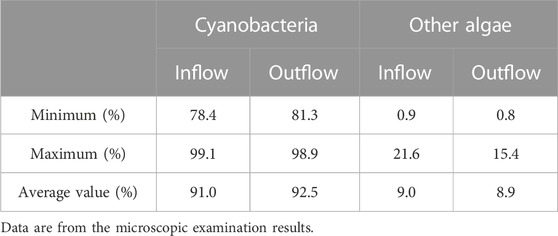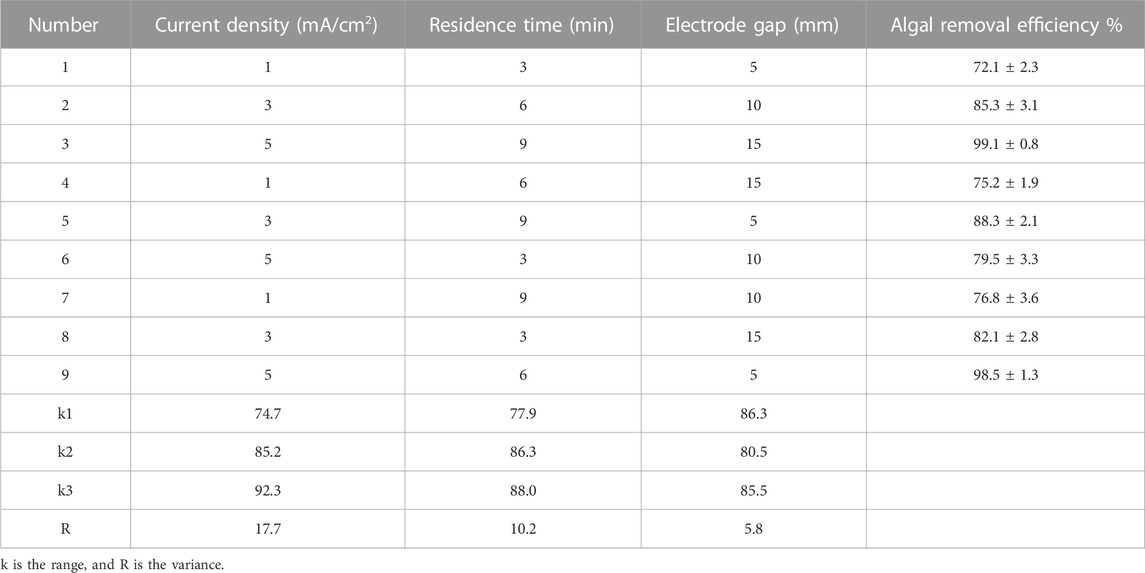- 1Guangdong Provincial Key Laboratory of Marine Disaster Prediction and Prevention, Shantou University, Shantou, China
- 2Fisheries Research Institute of Fujian, Xiamen, China
- 3Xiamen Stratford Technology Co., Ltd., Xiamen, China
- 4Laboratory of Marine Ecological Environment Early Warning and Monitoring, Third Institute of Oceanography, Ministry of Natural Resource, Xiamen, China
In order to reduce the influence of algae on the conventional treatment process of the water plant, the electro-flotation process was used to test the raw water of a lake-type reservoir. After raw water with cyanobacteria as the dominant algae is treated by the best electro-flotation process, the average removal rate of algal density can reach 99.1%. The effects of current density, residence time, and electrode spacing on the algal removal efficiency of the electro-floating process were investigated by orthogonal experiments. The order of influence was current density > residence time > electrode spacing. Considering economics, the optimal process conditions were as follows: the current density was 5 mA/cm2, the dwell time was 6 min, and electrode spacing was 10 mm.
1 Introduction
Eutrophication has caused serious algal blooms, which is a severe problem to water quality, particularly in tropical countries like China (Xia et al., 2016; Gu et al., 2021). The high algal pollution of domestic lakes and reservoirs is a common phenomenon. The famous Taihu Lake, Chaohu Lake, Dianchi Lake, Donghu Lake, and Dongting Lake, which were originally beautiful and pleasant, have been reduced to five types of inferior surface water in the past 20 years, with serious organic pollution and frequent occurrence of high algae (Yang, 2010; Jia et al., 2013; Zhao et al., 2015). Wuxi city has also caused serious consequences for the shutdown of water treatment plants in the entire city due to the bloom of cyanobacteria in Taihu Lake in recent years (Hu et al., 2010; Cao et al., 2022).
A high amount of algae in water is the result of the eutrophication of water sources (Smith, 2003; Chislock et al., 2013). The water quality is characterized by high algal density, high potassium permanganate index, high ammonia–nitrogen content, high nitrite content, high phycochlorotoxin concentration, and high concentration of some metal ions (Chen and Yeh, 2005; Cao et al., 2011). According to the summary of domestic engineering technology, when the average algae in lakes and reservoirs are more than 3 million cells/L, the conventional tap water treatment process can no longer be adapted, and the effluent quality generally exceeds the standard (Smith, 2003). The pH of water increases as a result of photosynthesis (Herath, 1997). The effect of algae changes the water quality, increases organic matter in water, and increases chlorine consumption. The treatment of water samples necessitates the use of numerous disinfectants (Smith, 2003; Hudnell, 2008).
In the last decade, many new technologies were introduced for algal removal in raw water with high algae sources, such as permanganate pretreatment, biological pretreatment, activated carbon adsorption, clay adsorption, diatomite adsorption, membrane filtration, and ultrasonic algal killing (Chen and Yeh, 2005; Rodriguez et al., 2015; Sun et al., 2018). However, in engineering applications, due to various reasons and the limitations to various technologies, the treatment effect of water with high algal sources with an algal density of above 4 million cells/L is not good, even if a project has adopted ultrafiltration in recent years (Herath, 1997; Mohamed, 2016; Zhan et al., 2021). However, the overall treatment effect is not ideal, membrane fouling is serious, and the algal membrane permeation rate is high. Therefore, based on the global research of high-algae source raw water treatment engineering technology in recent years, the study on the combination and integration of this treatment technology with high efficiency and strong applicability is a highly sought-after topic.
Electro-flotation is an alternative process in microalgal removal that utilizes non-sacrificial electrodes, such as carbon, graphite, and stainless steel. These non-sacrificial electrodes do not dissolve during the process, especially under low applied current and thus reduces water contamination to the lowest possible level if not completely (Gao et al., 2010; Tumsri and Chavalparit, 2011; Antonyováa and Antonyb, 2018). As one of the electrochemical technologies, it is based on the bubble creation. The bubble size directly influences the effectivity of the treatment process. The bubbles are created during the following electrolytic reaction:
Oxidation at the anode:
Reduction at the cathode:
Overall reaction:
In this study, the electro-flotation process was used to test the raw water of a lake-type reservoir to reduce the impact of high algal density on the conventional treatment process of the water plant. The effects of current density, residence time, and electrode spacing on the removal rate of algal density were analyzed.
2 Materials and methods
2.1 Device
As we know, algae are mostly semi-floating substances, and air flotation is an efficient algal removal measure. The traditional air flotation process mainly relies on the generation of a large number of micro-bubbles in water (the diameter of the bubbles is mostly above 100 μm) to let the algae float on the water surface for removal. The removal effect depends on the number of microbubbles and the size of the bubbles generated in the pool, and the smaller the bubbles, the more the bubbles and the stronger the buoyancy (Liu et al., 2014; Lu et al., 2016). In addition to electrochemical oxidation, the electrolysis process also produces a huge amount of 40-μm micro-bubbles; the effect of electrical flotation treatment is significantly higher than the traditional air flotation process (Min et al., 2005). However, due to the high energy consumption of electrolysis, the effective contact time of electrolysis must be significantly reduced in order to save energy. Therefore, in practical applications, the size of the electrolytic cell is usually quite small, and the air flotation effect is not usually the primary factor taken into consideration by the designer, thus limiting its treatment effect. This process involves combining the two air flotation processes into one, by installing an electro-flotation device in the liquid–solid separation of the traditional air flotation process, in order to make full use of the advantages of both techniques. Based on saving energy as much as possible, the algal removal efficiency of traditional air flotation tanks is significantly improved.
The experimental device was designed according to the aforementioned principles, as shown in Figure 1. The anode of the core part of the electrolytic cell is coated with nanoscale (≤20 nm) ruthenium, rhodium, and iridium chloride on the surface of the metal titanium, and after surface activation treatment, a thin oxide layer of ruthenium, rhodium, and iridium is formed on the titanium’s surface. Nanoscale ruthenium, rhodium, and iridium-mixed oxide coatings show a good electrocatalytic performance.
2.2 Microbubble measurement
The microbubble production rate (A) was calculated by monitoring the displacement of the water within the silicon tube for 5 min and then averaging the results (Figure 2). A was computed by multiplying the average water displacement by the silicon tube’s cross-sectional area. This is expressed by the following equation:
where A denotes the average microbubble production rate (cm3/min),
2.3 Raw water
The raw water used in the experiment is taken from Yundang Lake in the west of Xiamen city (Figure 3), and the main water quality indicators are shown in Table 1. The biomass of algae in the reservoir will be affected by the wet and dry seasons. The most common species of algae in raw water is Microcystis. The wet season runs from April to September in Xiamen city, during which time rainfall is relatively high, resulting in a decrease in the density of algae in the water body (Jiang et al., 2014).
2.4 Removal of algae
The algal cell density, an indicator to measure the algal killing effect, was counted using a 0.1-mL phytoplankton counting plate, and the calculation formula is as follows:
N is the number of algal cells per liter of water sample; A is the area of the counting frame (mm2); B is the area of a visual field (mm2); C is the number of visual fields during counting (number); D is the volume of 1 L of water after concentration (mL); E is the volume of the counting frame (mL); and F is the number of algae measured per piece.
3 Results and discussion
3.1 Effects of the electrode on microbubble generation
In this study, we considered the rate of microbubble generation as one important factor in choosing the suitable electrode for the experiment (Burns et al., 1997; Brasileiro et al., 2021). The plate and three types of mesh were tested for microbubble generation. In electro-flotation, three stages occur during gas evolution: nucleation, growth, and detachment. Generated microbubbles come from spots on the surface of the electrode called the nucleating sites, where the evolution of microbubbles takes place (Lucero et al., 2018). The number of these sites is more likely dependent on the surface area of the electrode. The more the surface area, the more nucleation sites are activated, which increases the microbubble generation rate.
In the case of the same size plate and different mesh-type electrodes, it is important to note the nucleating sites on the specific surface area. The smaller the mesh radius, the larger the specific surface area is. The increasing trend of the microbubble generation rate for these electrodes, as shown in Figure 4, is mainly because of the increase in the surface area.
3.2 Raw water algal content and composition
Cyanobacteria were the main algae in the raw water of the test water, accounting for 99.1% of the total algae with an average of 91.0%, occupying an absolute advantage. Table 2 shows that the fraction of other algae was relatively low. The reason might be that the test water is in the subtropical zone, where the temperature is rather high all year. The average yearly water temperature is roughly 24°C, with the maximum temperature of 32.1°C in August. So, the increased water temperature allows cyanobacteria to flourish, and their biomass is substantially higher than that of other algae.
3.3 Effects of current density, plate spacing, and residence time on algal removal
The main factors affecting the removal of algae include the water quality parameters of the test water, such as pH, turbidity, total nitrogen, and total phosphorus (Lucero et al., 2018; Hu et al., 2022), and the control parameters of the electro-flotation process, such as current density, electrode spacing, and residence time (Souza et al., 2016; Antonyováa and Antonyb, 2018). Under the current situation of general eutrophication of lakes and reservoirs, it is difficult to solve the problem of excessive endogenous nutrients in the short term, and it is impossible to fundamentally eliminate the basic conditions that lead to abnormal algal reproduction, therefore insisting on the implementation of source control strategies. At the same time, it is also necessary to take measures to optimize the process parameters for local waters to achieve the purpose of algal removal.
To investigate the effects of current density, residence time, and electrode spacing on the algal removal rate of the electro-flotation process, the current density was set to 1, 3, and 5 mA/cm2, and the residence time was set to 3, 6, and 9 min. The spacing was set to 5, 10, and 15 mm, and an orthogonal test was performed. The results are shown in Table 3.
From the range values shown in Table 3, it can be seen that the order of influence of each factor on the algal removal effect of electrolysis is current density > residence time > electrode spacing. According to Faraday’s law, the amount of gas precipitated on the electrode is proportional to the current density and residence time through the solution. In the nano-catalytic electro-flotation process, the longer the residence time, the higher the current density is, and the better the air flotation effect may be, but the energy consumption will be significantly increased. The smaller the resistance, the higher the rate of microbubble generation and the acceleration of the oxidative decomposition of organic matter are. However, if the distance between the plates is very small, algae will easily block the electrodes, and the plates are also prone to scaling, which is not conducive to the installation and maintenance of the electrodes.
Therefore, considering the economy, the optimal values are as follows: the current density is 5 mA/cm2, the dwell time is 6 min, and electrode spacing is 10 mm.
The electrical energy consumption of the electro-flotation (EF) process for algal removal was evaluated. The energy consumption W (kWh/m3) was calculated using
where U is the voltage (V), I is the applied electrolysis current (A), t is the electrolysis time (h), and V is the reactor volume (m3). According to our optimized experimental parameters, W is 0.18 kWh/m3.
Some other methods of algal removal are usually used. These techniques are mostly efficient reaching beyond 95%. However, they have disadvantages. Centrifugation is well known for its high energy consumption; removal by sedimentation requires large space; filtration is limited by clogging of filters; coagulation–flocculation uses elevated levels of coagulants and also requires longer contact time than any other separation methods.
An economic evaluation of the proposed process in this study was conducted to provide a reference. In terms of 1.0 Yuan/kWh in China, the total cost is 0.18 Yuan/m3 for raw water algae, which is low than the membrane-combined technology (0.49–0.91 Yuan/m3) (Huang et al., 2015) and electro-coagulation-flotation technology (0.29–0.60 Yuan/m3) (Gao et al., 2010).
3.4 Comparison of other algal removal methods
Several separation methods have recently been proven to be very effective in the removal of algae; however, not all are cost-effective or environmental friendly. Table 4 shows the comparison of some of the previous methods used in algal separation in water. Table 4 shows that flocculation and dissolved air flotation (DAF) provide excellent removal efficiency but typically necessitate a large number of coagulants. Excessive coagulant addition can cause water contamination, endangering humans and aquatic organisms. For example, an excess of Al2(SO4)3 in water has been linked to Alzheimer’s disease (Virk and Eslick, 2015). Furthermore, flocculation with chitosan is a viable option, but due to its high cost, it may be an impractical method of algal removal, particularly for large-scale operations.
4 Conclusion
Electro-flotation technology is an efficient way of broad-spectrum algal removal technology. After the raw water with cyanobacteria as the dominant algae is treated by the optimal process of electro-flotation, the average removal rate of algal density can reach up to 99.1%.
The main factors affecting the algal removal efficiency of the electro-flotation process are current density, residence time, and electrode spacing. Results showed that the current density was the most crucial factor for the removal of algae.
In general economic considerations, the optimum conditions are as follows: the current density was 5 mA/cm2, the flocculation time was 6 min, and electrode spacing was 10 mm.
Data availability statement
The original contributions presented in the study are included in the article/Supplementary Material; further inquiries can be directed to the corresponding authors.
Author contributions
SJ, FW, and FL contributed to the conception and design of the study. HD performed the statistical analysis. SJ wrote the first draft of the manuscript. All authors contributed to manuscript revision, read, and approved the submitted version.
Funding
This work was supported by the National Key Scientific and Technological Project (SQ2020YFF0426577), Public Welfare Project of Fujian Science and Technology Department (2020R1013001), Fujian Province Marine and Fishery Structure Adjustment Special Project (2021HYJG09, 2021HYJG10) and Special Fund for Marine Development of Fujian Province (FJHJF-L-2020-8, FJHJF-L-2022-13).
Conflict of interest
Author FW was employed by the company Xiamen Stratford Technology Co., Ltd.
The remaining authors declare that the research was conducted in the absence of any commercial or financial relationships that could be construed as a potential conflict of interest.
Publisher’s note
All claims expressed in this article are solely those of the authors and do not necessarily represent those of their affiliated organizations, or those of the publisher, the editors, and the reviewers. Any product that may be evaluated in this article, or claim that may be made by its manufacturer, is not guaranteed or endorsed by the publisher.
References
Antonyováa, A., and Antonyb, P. (2018). Electro-flotation as the method of the water treatment in recycling process of contaminated water as an integral part of the reverse logistics system. J. Southwest Jiaot. Univ. 53 (5).
Brasileiro, P., Silva, R. d. C. F. S. d., Santos, V., Sarubbo, L. A., and Benachour, M. (2021). Efficiency of microbubble production using surfactants for the treatment of oily water by flotation. Chem. Eng. Res. Des. 168, 254–263. doi:10.1016/j.cherd.2021.02.015
Burns, S. E., Yiacoumi, S., and Tsouris, C. (1997). Microbubble generation for environmental and industrial separations. Microbubble generation Environ. industrial Sep. 11 (3), 221–232. doi:10.1016/s1383-5866(97)00024-5
Cao, C., Zheng, B., Chen, Z., Huang, M., and Zhang, J. (2011). Eutrophication and algal blooms in channel type reservoirs: A novel enclosure experiment by changing light intensity. J. Environ. Sci. 23 (10), 1660–1670. doi:10.1016/s1001-0742(10)60587-6
Cao, H., Han, L., and Li, L. (2022). A deep learning method for cyanobacterial harmful algae blooms prediction in Taihu Lake, China. Harmful Algae 113, 102189. doi:10.1016/j.hal.2022.102189
Chen, J.-J., and Yeh, H.-H. (2005). The mechanisms of potassium permanganate on algae removal. Water Res. 39 (18), 4420–4428. doi:10.1016/j.watres.2005.08.032
Chislock, M. F., Doster, E., Zitomer, R. A., and Wilson, A. E. (2013). Eutrophication: Causes, consequences, and controls in aquatic ecosystems. Nat. Educ. Knowl. 4 (4), 10.
Gao, S., Yang, J., Tian, J., Ma, F., Tu, G., and Du, M. (2010). Electro-coagulation–flotation process for algae removal. J. Hazard. Mater. 177 (1), 336–343. doi:10.1016/j.jhazmat.2009.12.037
Gerde, J. A., Yao, L., Lio, J. Y., Wen, Z., and Tong, W. (2014). Microalgae flocculation: Impact of flocculant type, algae species and cell concentration. Algal Res. 3 (1), 30–35. doi:10.1016/j.algal.2013.11.015
Gu, H., Wu, Y., Lu, S., Lu, D., and Qi, Y. (2021). Emerging harmful algal bloom species over the last four decades in China. Harmful Algae 111, 102059. doi:10.1016/j.hal.2021.102059
Herath, G. (1997). Freshwater algal blooms and their control: Comparison of the European and Australian experience. J. Environ. Manag. 51 (2), 217–227. doi:10.1006/jema.1997.0138
Hu, C., Lee, Z., Ma, R., Yu, K., Li, D., and Shang, S. (2010). Moderate resolution imaging spectroradiometer (MODIS) observations of cyanobacteria blooms in Taihu Lake, China. J. Geophys. Res. Oceans 115 (C4), C04002. doi:10.1029/2009jc005511
Hu, L., Wang, R., Wang, M., Xu, Y., Wang, C., Liu, Y., et al. (2022). Research progress of photocatalysis for algae killing and inhibition: A review. Environ. Sci. Pollut. Res. 29 (32), 47902–47914. doi:10.1007/s11356-022-20645-9
Huang, W., Chu, H., Dong, B., Hu, M., and Yu, Y. (2015). A membrane combined process to cope with algae blooms in water. Desalination 355, 99–109. doi:10.1016/j.desal.2014.09.037
Hudnell, H. K. (2008). Cyanobacterial harmful algal blooms: State of the science and research needs.
Hyuckjin, K., Mingshou, Lu, Eun, Y., and Lee, J. (2014). Harvesting of microalgae using flocculation combined with dissolved air flotation. Biotechnol. Bioprocess Eng.
Jia, P., Zhang, W., and Liu, Q. (2013). Lake fisheries in China: Challenges and opportunities. Fish. Res. 140, 66–72. doi:10.1016/j.fishres.2012.12.007
Jiang, R., He, Q., Kuang, W., and Ji, W. (2014). Assessment of eutrophication status in Xiamen coastal waters. Oceanol. Limnologia Sinica/Hai Yang Yu Hu Chao 45 (4), 710–718.
Liu, Q., Zhao, C., Yan, M., and Zhao, T. (2014). Operational characteristics of a flotation/bio-ceramsite/membrane integrated process in micro-polluted lake water treatment. Chin. J. Environ. Eng. 8 (12), 5249–5253.
Lu, Y., Zhang, F., Zhang, Y., Hu, K., and Wang, S. (2016). Research of oily wastewater treatment by micro-bubble flotation experimental device. International Field Exploration and Development Conference (IFEDC), Beijing, 1–4. doi:10.1049/cp.2016.1384
Lucero, A., Park, Y.-S., and Kim, D.-S. (2018). Removal of freshwater microalgae by flocculation-enhanced electro-flotation using stainless steel mesh electrode. Arabian J. Sci. Eng. 43 (5), 2339–2351. doi:10.1007/s13369-017-2712-y
Min, S.-W., Hahn, M., Kim, J., and Lee, B. (2005). Three-dimensional electro-floating display system using an integral imaging method. Opt. Express 13 (12), 4358–4369. doi:10.1364/opex.13.004358
Mohamed, Z. A. (2016). Breakthrough of Oscillatoria limnetica and microcystin toxins into drinking water treatment plants-examples from the Nile River, Egypt. Water SA 42 (2), 161–165. doi:10.4314/wsa.v42i1.16
Rodriguez, C., Alaswad, A., Mooney, J., Prescott, T., and Olabi, A. (2015). Pre-treatment techniques used for anaerobic digestion of algae. Fuel Process. Technol. 138, 765–779. doi:10.1016/j.fuproc.2015.06.027
Şirin, S., Trobajo, R., Ibanez, C., and Salvadó, J. (2011). Harvesting the microalgae Phaeodactylum tricornutum with polyaluminum chloride, aluminium sulphate, chitosan and alkalinity-induced flocculation. J. Appl. Journal Appl. Phycol. 24 (5), 1067–1080. doi:10.1007/s10811-011-9736-6
Smith, V. H. (2003). Eutrophication of freshwater and coastal marine ecosystems a global problem. Environ. Sci. Pollut. Res. 10 (2), 126–139. doi:10.1065/espr2002.12.142
Souza, F. L., Cotillas, S., Saéz, C., Cañizares, P., Lanza, M. R., Seco, A., et al. (2016). Removal of algae from biological cultures: A challenge for electrocoagulation? J. Chem. Technol. Biotechnol. 91 (1), 82–87. doi:10.1002/jctb.4580
Sun, R., Sun, P., Zhang, J., Esquivel-Elizondo, S., and Wu, Y. (2018). Microorganisms-based methods for harmful algal blooms control: A review. Bioresour. Technol. 248, 12–20. doi:10.1016/j.biortech.2017.07.175
Tumsri, K., and Chavalparit, O. (2011). Optimizing electrocoagulation-electroflotation process for algae removal. Singapore: SINGAPORE, 452–456.
Virk, S. A., and Eslick, G. D. (2015). Aluminum levels in brain, serum, and cerebrospinal fluid are higher in Alzheimer’s disease cases than in controls: A series of meta-analyses. J. Alzheimer’s Disease. 629–638. doi:10.3233/JAD-150193
Xia, R., Zhang, Y., Critto, A., Wu, J., Fan, J., Zheng, Z., et al. (2016). The potential impacts of climate change factors on freshwater eutrophication: Implications for research and countermeasures of water management in China. Sustainability 8, 229. doi:10.3390/su8030229
Yang, D. (2010). “The China environment yearbook,” in Tragedy and Hope-From the Sichuan Earthquake to the Olympics (Brill), (Leiden), 4.
Zhan, M.-m., Liu, P.-r., Liu, X.-y., Hong, Y., and Xie, X. (2021). Inactivation and removal technologies for algal-bloom control: Advances and challenges. Curr. Pollut. Rep. 7 (3), 392–406. doi:10.1007/s40726-021-00190-8
Keywords: electro-flotation, algae, orthogonal test, cyanobacteria, raw water
Citation: Jiang S, Wang F, Lin F and Du H (2023) Algal removal from raw water by electro-flotation. Front. Environ. Sci. 11:1057672. doi: 10.3389/fenvs.2023.1057672
Received: 29 September 2022; Accepted: 30 January 2023;
Published: 16 February 2023.
Edited by:
Khalid Bani-Melhem, Hashemite University, JordanReviewed by:
Jianhua He, Sichuan University, ChinaMuhammad Rasool Al-Kilani, The University of Jordan, Jordan
Zakaria Mohamed, Sohag University, Egypt
Copyright © 2023 Jiang, Wang, Lin and Du. This is an open-access article distributed under the terms of the Creative Commons Attribution License (CC BY). The use, distribution or reproduction in other forums is permitted, provided the original author(s) and the copyright owner(s) are credited and that the original publication in this journal is cited, in accordance with accepted academic practice. No use, distribution or reproduction is permitted which does not comply with these terms.
*Correspondence: Feng Lin, bGluZmVuZ0B0aW8ub3JnLmNu; Hong Du, aGR1QHN0dS5lZHUuY24=
 Shuangcheng Jiang1,2
Shuangcheng Jiang1,2 Feng Lin
Feng Lin Hong Du
Hong Du
